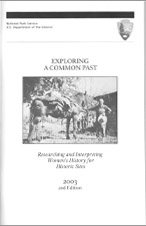Book Review
Exploring a Common Past: Researching and Interpreting Women's History for Historic Sites
Essays by Sara Evans, Leslie N. Sharp, Jill Cowley, and Shaun Eyring. Second Edition, Washington, DC: U.S. Department of the Interior, National Park Service, 2003; 56 pp., notes, bibliography; free of charge. Available online at http://www.nps.gov/parkhistory/hisnps/npshistory/womenshistory.pdf.
 |
Anne M. Derousie, historian at Women's Rights National Historical Park, and Susan Ferentinos, public history coordinator for the Organization of American Historians, produced this booklet under a cooperative agreement between the National Park Service and the organization. The booklet comprises Derousie's introduction and three short essays: Sara M. Evans's review of "Women's History Scholarship," Jill Cowley and Shaun Eyring's overview of "Women's History and Cultural Landscapes," and Leslie N. Sharp's comments on "Women's History and the Built Environment."
The publication is the first in a series that is "designed to assist historic site managers, historians and interpreters in the ongoing process of reviewing and evaluating interpretive programs and media and adjusting them in light of recent scholarship." Because the managers, historians, and interpreters likely will have various backgrounds, the National Park Service introduces them to some of the key questions that command the attention of historians of women. A comment by Sharpe that "one key to improving the documentation of historic properties in terms of women's history is to ask better questions" characterizes the goal of the publication. Each of the authors does an excellent job of synthesizing a wide variety of materials into concise articles. Evans, Cowley, and Eyring link their comments to specific sites around the country, while Sharp relies on examples from Georgia that seem more linked to National Register of Historic Places listings than to national parks.
The book concludes with a 20-page bibliography, the longest section in the booklet, which is divided among reference works on women's history, resources on women and the built environment, resources on women and cultural landscapes, general resources on women's history, and biographies. All of the citations are books, so perhaps the booklet's coordinators made a conscious decision to omit some of the excellent women's history websites. Almost every bibliographic citation in the first four sections includes a brief annotation, but why these are not available for every citation is not clear. Nor is it clear why none of the books in the biographies section has annotations. Most readers will recognize Clara Barton and Elizabeth Cady Stanton immediately, but Martha Ballard and Sarah Winnemucca, the subjects of other books in this section, are probably less well-known. Some references to local history resources (city directories, maps, diaries, census records, vital statistics, etc.) that historians and interpreters might use to research their sites would have made the bibliography more useful.
Space must have been a major constraint, though, since there are no illustrations beyond the cover photograph to help the reader understand the authors' perspectives. This is a particularly glaring omission, at least to this reviewer, in the article on cultural landscapes where the authors discuss sites like the Lockhart Ranch at Bighorn Canyon National Recreation Area and the Knife River Indian Villages National Historic Site in South Dakota, which few readers outside the National Park Service are likely to know.
Exploring a Common Past is a useful aid to historic site staff who must address a range of topics in their daily work. Although parts are inconsistent, overall the publication will help integrate the history of women into the narrative of American history.
Barbara Howe
West Virginia University
